An attractive view of the cottage and its surroundings is provided not only by vegetation. It is also helped to shape recreational and purely decorative structures. Among them is a pergola for grapes.
What is a pergola
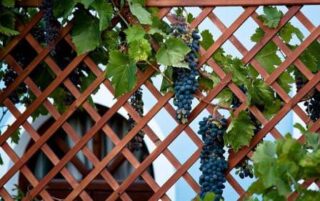
The structure is a grape pavilion, consisting of several arches, united by a mesh roof. This is a convenient way to grow grapes and turn them into an ornamental plant like climbing ivy. Saves space, which is important for small areas.
The vine branches are tied vertically to form a green wall. The illumination of the leaves has a good effect on the yield. The berries are large and juicy as a result. Air access from all directions reduces the likelihood of infection by fungi and bacteria. The plants are cared for in the same way as for standard cultivation. The family can relax in the shade of the gazebo.
Types of structures by shape and material
Most often, a pergola is made of wood or metal. The design option is selected so that it fits into the design of the site. For a stone house, a wrought-iron gazebo is well suited. With a sufficient budget, the construction itself is made of stone. If the dwelling is wooden, the pergola is also made from this material. With limited funds, you can make a simple but durable structure from professional pipes.
In addition to a simple gazebo, the pergola can be in the form of an arch. Most often it is made semicircular, but other shapes are also possible. In areas of a small area, you can organize a structure adjacent to the building.
Wooden pergola
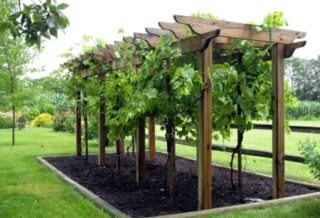
The material is attractive for environmental friendliness, accessibility, external compatibility with the landscape of the suburban area. A wooden pergola for grapes can be made of larch, acacia or oak. These are not the cheapest breeds, but structures made of them are durable and tolerate moisture better. With an insufficient budget, you can take pine or spruce. The design can be supplemented with a wooden table and a bench.
To make the pergola last longer, you need to use only well-dried building materials. They must be treated with antiseptics and moisture-repellent impregnations. Resin is applied to the structure every year to prevent damage from precipitation.
Metal pergolas for grapes
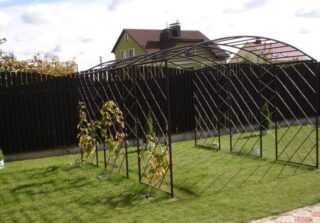
You can also make a metal pergola for grapes. It does not require regular maintenance, but welding skills are required for manufacturing. The material is usually shaped pipes. To prevent corrosion processes, the structure is coated with a protective paint. You can also make a forged pergola by independently preparing a drawing or using an existing scheme.
Plastic as pergola material
Plastic is chosen because of its frost resistance and ease of assembly of the structure. A mounting kit can be purchased at a gardening store. Plastic products are easy to clean, are not affected by parasites, do not fade under the influence of ultraviolet radiation. Visually, they may not fit into the landscape, but as they grow, the shoots will more and more cover the plastic.
It is best to install a polycarbonate structure - it is durable and resistant to precipitation. On sale you can find pergolas in different colors, including transparent ones.PVC should not be taken as a basis: when heated in the sun, the material emits harmful substances.
Stone pergolas
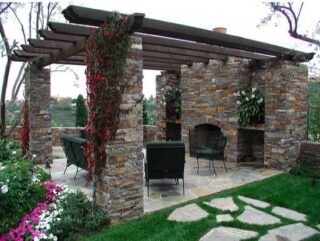
Such structures are the most reliable, have an expensive and aesthetic appearance and can be used for decades. They are not afraid of moisture, temperature jumps and mechanical stress. Both natural stones and artificial ones can be used for them. For the price, this is an expensive option that cannot be realized with your own hands. Nearby, you can organize a rose garden or wrap around the structure instead of grapes with ivy or vines. Sometimes the landscape is complemented with sculptural structures corresponding to the chosen style.
How to make a grape pergola
The pergola is a permanent structure, it cannot be moved to another place or disassembled with the onset of cold weather. Doing so will injure the vine. It is necessary to determine in advance the place of installation of the structure. It should be well lit. The grapes must be easily accessible.
Before construction work, you need to make a drawing of the desired structure in advance, showing its components and their dimensions. In accordance with it, the amount of materials is calculated. The pergola should not be too large, otherwise it will not be completely overgrown with vines. The material must be strong enough to support heavy bunches.
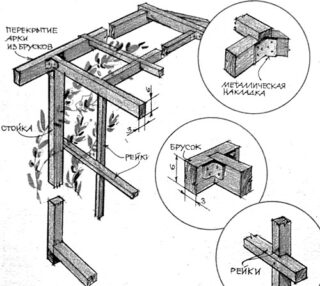
If it is decided to make the structure of wood, the supports are made of logs or timber. The building materials used are treated with an antiseptic. Pine wood planks are suitable for the roof. From tools and other materials you will need:
- ax;
- saw;
- jigsaw;
- screwdriver;
- a hammer;
- construction tape and level;
- screws, nails, screws;
- components for concrete mix;
- crushed stone.
The lumber is adjusted in size, the ends of the beams and the sheathing are designed in accordance with the project. On the upper parts of the supports, grooves are made to fix the beams, and the lower ones are coated with a waterproofing compound in 3 layers to the depth of concrete pouring.
The diameter of the hole for installing the support should be 2.5-3 times higher than that of the racks, and the depth, if possible, go further than the freezing point of the soil.
At the bottom, a cushion of rubble is made and the supports are placed strictly vertically. Instead of concreting, a tightly compacted backfill of gravel and sand is permissible. When the concrete gains strength, the supports are connected to the beams. Slopes are also installed using self-tapping screws. Sheathing boards are mounted on the beams. Then you can decorate the structure with decorative wooden elements.








